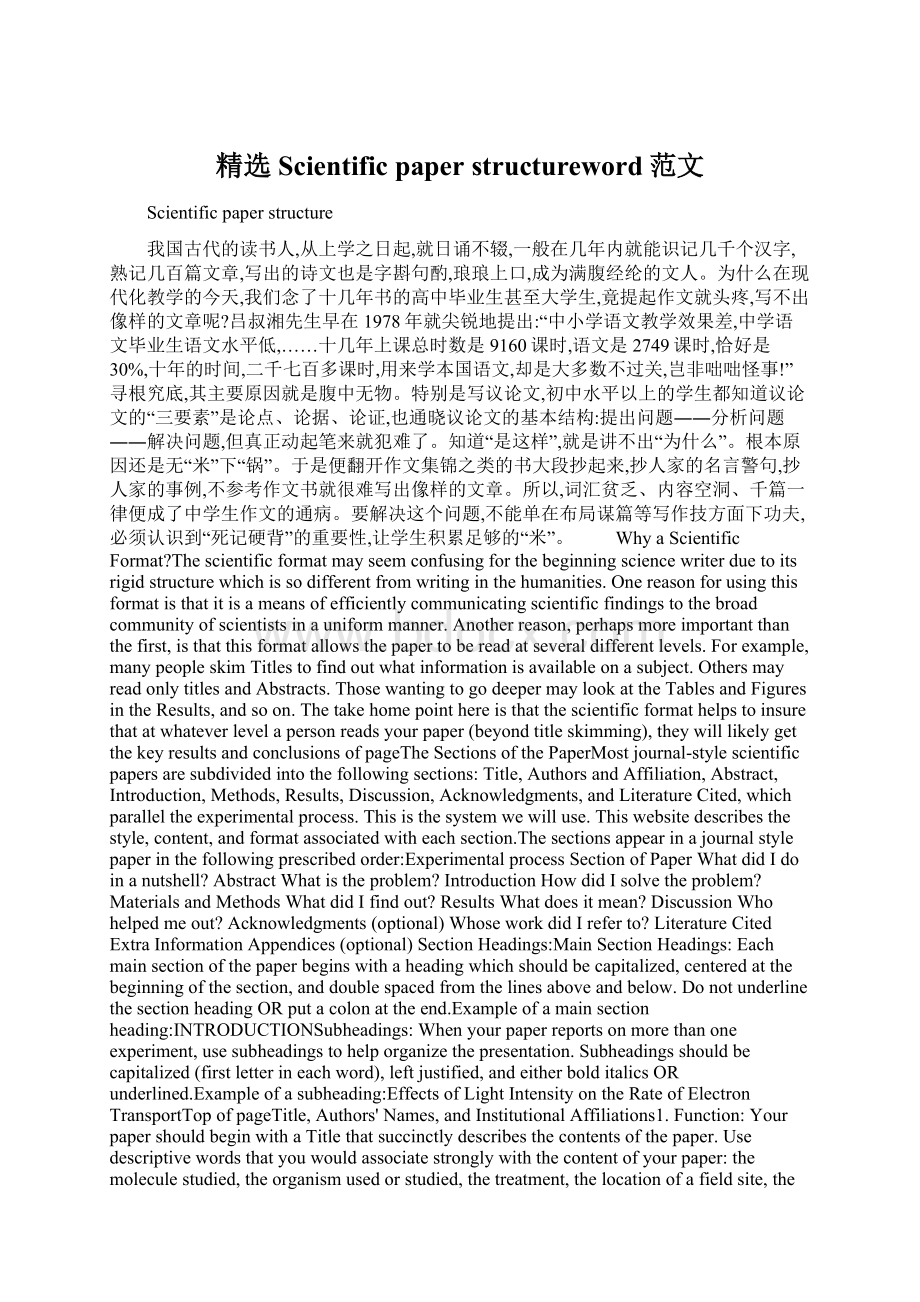精选Scientific paper structureword范文.docx
《精选Scientific paper structureword范文.docx》由会员分享,可在线阅读,更多相关《精选Scientific paper structureword范文.docx(7页珍藏版)》请在冰豆网上搜索。

精选Scientificpaperstructureword范文
Scientificpaperstructure
我国古代的读书人,从上学之日起,就日诵不辍,一般在几年内就能识记几千个汉字,熟记几百篇文章,写出的诗文也是字斟句酌,琅琅上口,成为满腹经纶的文人。
为什么在现代化教学的今天,我们念了十几年书的高中毕业生甚至大学生,竟提起作文就头疼,写不出像样的文章呢?
吕叔湘先生早在1978年就尖锐地提出:
“中小学语文教学效果差,中学语文毕业生语文水平低,……十几年上课总时数是9160课时,语文是2749课时,恰好是30%,十年的时间,二千七百多课时,用来学本国语文,却是大多数不过关,岂非咄咄怪事!
”寻根究底,其主要原因就是腹中无物。
特别是写议论文,初中水平以上的学生都知道议论文的“三要素”是论点、论据、论证,也通晓议论文的基本结构:
提出问题――分析问题――解决问题,但真正动起笔来就犯难了。
知道“是这样”,就是讲不出“为什么”。
根本原因还是无“米”下“锅”。
于是便翻开作文集锦之类的书大段抄起来,抄人家的名言警句,抄人家的事例,不参考作文书就很难写出像样的文章。
所以,词汇贫乏、内容空洞、千篇一律便成了中学生作文的通病。
要解决这个问题,不能单在布局谋篇等写作技方面下功夫,必须认识到“死记硬背”的重要性,让学生积累足够的“米”。
WhyaScientificFormat?
Thescientificformatmayseemconfusingforthebeginningsciencewriterduetoitsrigidstructurewhichissodifferentfromwritinginthehumanities.Onereasonforusingthisformatisthatitisameansofefficientlycommunicatingscientificfindingstothebroadcommunityofscientistsinauniformmanner.Anotherreason,perhapsmoreimportantthanthefirst,isthatthisformatallowsthepapertobereadatseveraldifferentlevels.Forexample,manypeopleskimTitlestofindoutwhatinformationisavailableonasubject.OthersmayreadonlytitlesandAbstracts.ThosewantingtogodeepermaylookattheTablesandFiguresintheResults,andsoon.Thetakehomepointhereisthatthescientificformathelpstoinsurethatatwhateverlevelapersonreadsyourpaper(beyondtitleskimming),theywilllikelygetthekeyresultsandconclusionsofpageTheSectionsofthePaperMostjournal-stylescientificpapersaresubdividedintothefollowingsections:
Title,AuthorsandAffiliation,Abstract,Introduction,Methods,Results,Discussion,Acknowledgments,andLiteratureCited,whichparalleltheexperimentalprocess.Thisisthesystemwewilluse.Thiswebsitedescribesthestyle,content,andformatassociatedwitheachsection.Thesectionsappearinajournalstylepaperinthefollowingprescribedorder:
ExperimentalprocessSectionofPaperWhatdidIdoinanutshell?
AbstractWhatistheproblem?
IntroductionHowdidIsolvetheproblem?
MaterialsandMethodsWhatdidIfindout?
ResultsWhatdoesitmean?
DiscussionWhohelpedmeout?
Acknowledgments(optional)WhoseworkdidIreferto?
LiteratureCitedExtraInformationAppendices(optional)SectionHeadings:
MainSectionHeadings:
Eachmainsectionofthepaperbeginswithaheadingwhichshouldbecapitalized,centeredatthebeginningofthesection,anddoublespacedfromthelinesaboveandbelow.DonotunderlinethesectionheadingORputacolonattheend.Exampleofamainsectionheading:
INTRODUCTIONSubheadings:
Whenyourpaperreportsonmorethanoneexperiment,usesubheadingstohelporganizethepresentation.Subheadingsshouldbecapitalized(firstletterineachword),leftjustified,andeitherbolditalicsORunderlined.Exampleofasubheading:
EffectsofLightIntensityontheRateofElectronTransportTopofpageTitle,Authors'Names,andInstitutionalAffiliations1.Function:
YourpapershouldbeginwithaTitlethatsuccinctlydescribesthecontentsofthepaper.Usedescriptivewordsthatyouwouldassociatestronglywiththecontentofyourpaper:
themoleculestudied,theorganismusedorstudied,thetreatment,thelocationofafieldsite,theresponsemeasured,etc.Amajorityofreaderswillfindyourpaperviaelectronicdatabasesearchesandthosesearchengineskeyonwordsfoundinthetitle.2.TitleFAQs3.Format:
Thetitleshouldbecenteredatthetopofpage1(DONOTuseatitlepage-itisawasteofpaperforourpurposes);thetitleisNOTunderlinedoritalicized.theauthors'names(PIorprimaryauthorfirst)andinstitutionalaffiliationaredouble-spacedfromandcenteredbelowthetitle.Whenmorethentwoauthors,thenamesareseparatedbycommasexceptforthelastwhichisseparatedfromthepreviousnamebytheword"and".Forexample:
DucksOver-WinterinColoradoBarleyFieldsinResponsetoIncreasedDailyMeanTemperatureImaMallard,UraDrake,andWoodruffDucqueDepartmentofWildlifeBiology,UniversityofColorado-BoulderTopofpageThetitleisnotasection,butitisnecessaryandimportant.Thetitleshouldbeshortandunambiguous,yetbeanadequatedescriptionofthework.Ageneralrule-of-thumbisthatthetitleshouldcontainthekeywordsdescribingtheworkpresented.Rememberthatthetitlebecomesthebasisformoston-linecomputersearches-ifyourtitleisinsufficient,fewpeoplewillfindorreadyourpaper.Forexample,inapaperreportingonanexperimentinvolvingdosingmicewiththesexhormoneestrogenandwatchingforacertainkindofcourtshipbehavior,apoortitlewouldbe:
MouseBehaviorWhy?
Itisverygeneral,andcouldbereferringtoanyofanumberofmousebehaviors.Abettertitlewouldbe:
TheEffectsofEstrogenontheNose-TwitchCourtshipBehaviorinMiceWhy?
Becausethekeywordsidentifyaspecificbehavior,amodifyingagent,andtheexperimentalorganism.Ifpossible,givethekeyresultofthestudyinthetitle,asseeninthefirstexample.Similarly,theabovetitlecouldberestatedas:
EstrogenStimulatesIntensityofNose-TwitchCourtshipBehaviorinMice4.StrategyforWritingTitleofpageABSTRACT1.Function:
Anabstractsummarizes,inoneparagraph(usually),themajoraspectsoftheentirepaperinthefollowingprescribedsequence:
thequestionyouinvestigated(orpurpose),(fromIntroduction)statethepurposeveryclearlyinthefirstorsecondsentence.theexperimentaldesignandmethodsused,(fromMethods)clearlyexpressthebasicdesignofthestudy.Nameorbrieflydescribethebasicmethodologyusedwithoutgoingintoexcessivedetail-besuretoindicatethekeytechniquesused.themajorfindingsincludingkeyquantitativeresults,ortrends(fromResults)reportthoseresultswhichanswerthequestionsyouwereaskingidentifytrends,relativechangeordifferences,etc.abriefsummaryofyourinterpetationsandconclusions.(fromDiscussion)clearlystatetheimplicationsoftheanswersyourresultsgaveyou.WhereastheTitlecanonlymakethesimpleststatementaboutthecontentofyourarticle,theAbstractallowsyoutoelaboratemoreoneachmajoraspectofthepaper.ThelengthofyourAbstractshouldbekepttoabout200-300wordsmaximum(atypicalstandardlengthforjournals.)Limityourstatementsconcerningeachsegmentofthepaper(i.e.purpose,methods,results,etc.)totwoorthreesentences,ifpossible.TheAbstracthelpsreadersdecidewhethertheywanttoreadtherestofthepaper,oritmaybetheonlyparttheycanobtainviaelectronicliteraturesearchesorinpublishedabstracts.Therefore,enoughkeyinformation(e.g.,summaryresults,observations,trends,etc.)mustbeincludedtomaketheAbstractusefultosomeonewhomaytoreferenceyourworkofpageHowdoyouknowwhenyouhaveenoughinformationinyourAbstract?
Asimplerule-of-thumbistoimaginethatyouareanotherresearcherdoinganstudysimilartotheoneyouarereporting.IfyourAbstractwastheonlypartofthepaperyoucouldaccess,wouldyoubehappywiththeinformationpresentedthere?
2.Style:
TheAbstractisONLYtext.Usetheactivevoicewhenpossible,butmuchofitmayrequirepassiveconstructions.WriteyourAbstractusingconcise,butcomplete,sentences,andgettothepointquickly.Usepasttense.Maximumlengthshouldbe200-300words,usuallyinasingleparagraph.TheAbstractSHOULDNOTcontain:
lengthybackgroundinformation,referencestootherliterature,elliptical(i.e.,endingwith...)orincompletesentences,abbreviationsortermsthatmaybeconfusingtoreaders,anysortofillustration,figure,ortable,orreferencestothem.Topofpage3.Strategy:
Althoughitisthefirstsectionofyourpaper,theAbstract,bydefinition,mustbewrittenlastsinceitwillsummarizethepaper.TobegincomposingyourAbstract,takewholesentencesorkeyphrasesfromeachsectionandputtheminasequencewhichsummarizesthepaper.Thensetaboutrevisingoraddingwordstomakeitallcohesiveandclear.AsyoubecomemoreproficientyouwillmostlikelycomposetheAbstractfromscratch.4.Checkyourwork:
Onceyouhavethecompletedabstract,checktomakesurethattheinformationintheabstractcompletelyagreeswithwhatiswritteninthepaper.ConfirmthatalltheinformationappearingtheabstractactuallyappearsinthebodyofthepaperofpageINTRODUCTION[strategy|FAQs|style|structure|relevantliteraturereview|statementofpurpose|rationale]1.Function:
ThefunctionoftheIntroductionisto:
Establishthecontextoftheworkbeingreported.Thisisaccomplishedbydiscussingtherelevantprimaryresearchliterature(withcitations)andsummarizingourcurrentunderstandingoftheproblemyouareinvestigating;Statethepurposeoftheworkintheformofthehypothesis,question,orproblemyouinvestigated;and,Brieflyexplainyourrationaleandapproachand,wheneverpossible,thepossibleoutcomesyourstudycanreveal.Quiteliterally,theIntroductionmustanswerthequestions,"WhatwasIstudying?
Whywasitanimportantquestion?
WhatdidweknowaboutitbeforeIdidthisstudy?
Howwillthisstudyadvanceourknowledge?
"2.Style:
Usetheactivevoiceasmuchaspossible.Someuseoffirstpersonisokay,butdonotoverdoitofpage3.Structure:
ThestructureoftheIntroductioncanbethoughtofasaninvertedtriangle-thebroadestpartatthetoprepresentingthemostgeneralinformationandfocusingdowntothespecificproblemyoustudied.OrganizetheinformationtopresentthemoregeneralaspectsofthetopicearlyintheIntroduction,thennarrowtowardthemorespecifictopicalinformationthatprovidescontext,finallyarrivingatyourstatementofpurposeandrationale.AgoodwaytogetontrackistosketchouttheIntroductionbackwards;startwith